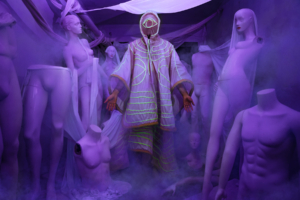You may have seen the signs by the Morgan Avenue L station or on the gates encircling the Bushwick Market at 54 Wyckoff Ave. mentioning some kind of movement known as “Floraissance Vivarium.” There are no names on the signs, but there is a barcode leading back to a website.
Only by visiting the Floraissance website will you see the name of the person who coined the term: André Feliciano, a Brazilian artist who defines the Floraissance as an emerging era of art culture that shifts the focus from contemporary creation to the intentional cultivation of ideas. Feliciano’s work has also been featured in Photoville 2012, and his camera flower installation has been included in the São Paulo Museum of Modern Art (MAM), the Tomie Ohtake Institute and São Paulo’s Goethe Institute.
The name of the movement itself was inspired by the Renaissance, when European society experienced a type of rebirth in humanism and the sciences. The Floraissance, however, incorporates the word “flor,” which means “flower” in English. According to Feliciano, the image of the flower is symbolic of a feminine epoch, where cultivation occurs not only in the garden but also from human nature.
The Floraissance recognizes that, throughout history, nature has been defined through different perspectives. With the rise of the Anthropocene, the era in which we currently live, humans are viewed as the dominant influential force on the environment. Floraissance questions how humanity can develop a new relationship with nature to preserve Earth.
The people who participate in the movement are befittingly referred to as “art gardeners” because, according to Feliciano, the movement is about fostering a “long-term mentality” that will eventually permeate consciousness.
“To reconnect with nature is not only to spend the weekend in a cabin, but most importantly, it is to develop a long-term mentality lifestyle. To recycle your garbage, generate your own energy or eat food from sustainable practices, for example, is a way to reconnect with nature in the long term, not only in a contemporary moment,” Feliciano explained. “This movement goes forward, but it also goes back. So it’s taking place in the past, present and future.”
If you visit the Floraissance website, you’ll see that there is a “For Kids” section that is updated regularly to include videos on sustainability and energy preservation that Feliciano himself has recorded as a teacher of the USDAN Summer Camp of the Arts sustainable design program. He has been teaching there every summer since 2017.
“Cultivation is about sharing knowledge,” said Feliciano. “It’s about instilling ideas. Our biggest issue is with energy; how can we get energy without harming the planet?” he asked. “And energy is everywhere. It could even be found in the swinging of a hammock, and I didn’t know that before!”
Given the extenuating circumstance of the ongoing pandemic, the Floraissance has experienced a period of stagnancy. Even before the initial lockdown, the people who would reach out to Feliciano would show only temporary interest or make a minimal effort to attend the movement’s pop-up meetings, but Feliciano shared that he’s hopeful, now that stores are opening up and there’s more of a buzz on the streets. Floraissance recently had its first Vivarium exhibition this past November in Mexico City.
“I once had someone who saw a sign message me to ask if she could use the name ‘Floraissance’ in her book title. I told her, ‘Of course,’ because it’s public domain, but just know that someone else can use it too,” said Feliciano. In another instance, someone had contacted Feliciano to let him know she’d be changing her name to “Floraissance” on Instagram.
“I have no control over how people will react to the Floraissance,” commented Feliciano.
Feliciano is expecting to return to New York City in March of 2022 and will be visiting Bushwick to put up new signs as well as to network with the community for ideas. To see images of all the signs around New York City, visit the Floraissance gallery or its Instagram account. There are also signs set up in Mexico, Brazil and Berlin.
If you want to learn more about the Floraissance, from the encounter that sprouted the conversation to the definition of ecological art, you can read the Floraissance book, provided on the website. The book is licensed under Creative Commons and invites anyone with suggestions, comments or feedback to email [email protected].
Featured image: provided by André Feliciano
For more news, sign up for Bushwick Daily’s newsletter.
Join the fight to save local journalism by becoming a paid subscriber.



